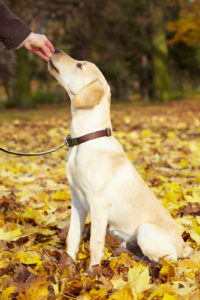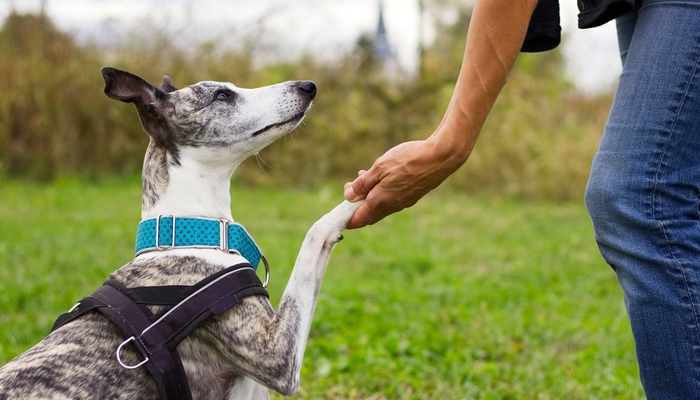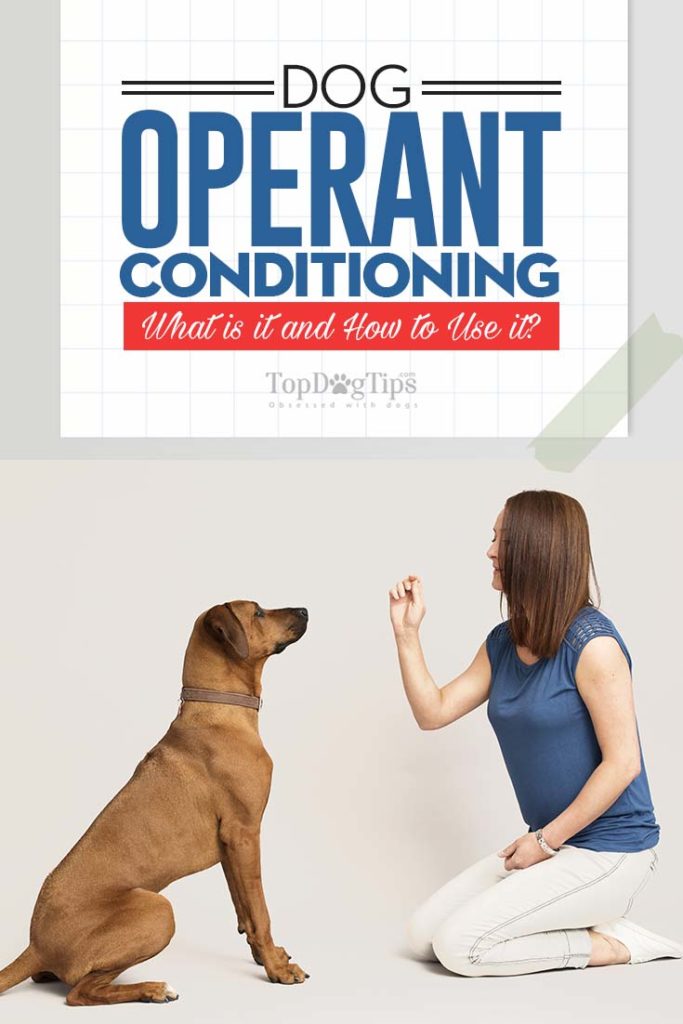Table of Contents
You have been working with your dog’s behavior so that the two of you can be more social with family members and other dogs. But you're quickly learning that dog training is more difficult than you originally thought. There are many different methods of training that have be proven to be successful, and dog operant conditioning is one of the easiest methods to use.
You try all these different methods and toys only to end up frustrated and faced with your dog still displaying the same types of unwanted behaviors while looking up at you and gladly wagging his tail. So, now, what do you do?
Your dog is a wonderful companion, but in order to produce the desired behaviors you will have to learn to communicate in a language that he can understand. This will involve both sending and receiving cross-species communications that are both verbal and non-verbal.
Dogs are able to learn a variety of words and also understand voice tone and gestures. Professional dog trainers often refer to these directions as commands. Using dog operant conditioning is one of the best ways to teach your general dog training commands effectively.
MORE: Most Effective Dog Training Methods (According to Science)
Dog Operant Conditioning
what it is and how to use it in dog training
Starting with Dog Training
As a new pet owner, you are thinking that you just want to teach your dog the basics. Sit, lay down, stay, no, heel, and come are some common commands that people will teach their dogs. Following a command is a reaction or behavior in response to a stimulus.
You will be using a form of psychology on your dog because anytime you alter a behavior in this manner, you are relying on the universal laws of learning theory. Many trainers can call their dog training program principles almost anything, but their terminology use doesn’t matter.
They are all doing the same thing, applying psychological principals of classical and operant conditioning.
Classical conditioning generally occurs when the subject learns to associate two different stimuli. There are no behaviors involved. Operant conditioning generally causes a behavior.
Dog training happens through operant conditioning. It is the way a dog learns or is conditioned from the way it behaves or operates in its environment. In dog operant conditioning, the change in behavior will happen either more often or less often, depending on positive and negative results.
Using positive and negative reinforcement is a way that dog operant conditioning can alter the behavior in dogs. If you are using consequences that make your dog upset when he does something wrong and reward your dog when he does something right, then you are already using dog operant conditioning.
RELATED: Science-Based Dog Training – How Research Influenced Our Approach On Training Dogs
Using Behavior Modification Techniques
 When you sit down with your dog and practice giving it treats and rewards for doing certain behaviors like sitting or shaking, you are using operant conditioning. The scientists that are responsible for learning the benefits of operant conditioning are Pavlov and B.F. Skinner.
When you sit down with your dog and practice giving it treats and rewards for doing certain behaviors like sitting or shaking, you are using operant conditioning. The scientists that are responsible for learning the benefits of operant conditioning are Pavlov and B.F. Skinner.
Reward-based training has been shown to be effective in changing both behaviors and emotions in an animal. In dog operant conditioning, there are different types of behavioral techniques or operant procedures.
When using behavior modification techniques, it is important to learn the following operant procedures. These are considered standard behavior modification techniques.
1. Positive Reinforcement
The power of positive reinforcement helps change and shape behavior in your dog. This occurs when a motivating item, such as a treat or a head pat, is presented after your dog exhibits the desired behavior. It means that it is more likely to happen again in the future.
2. Negative Reinforcement
When negative reinforcement is used to change your dog’s behavior. It means that your dog is responding because it allows him to escape, get rid of, or avoid something that he does not want.
3. Using Punishment
Punishment is most effective when you use it on your dog, right when you find your dog acting out some type of forbidden behavior or immediately afterward. You, as an owner, should take some type of non-injurious action that will turn the experience into a sudden emotional upset for your dog.
You want your dog to relate his actions to an unpleasant experience. You should always concentrate on current offenses. Your dog will be confused if you try to seek punishment as a way of training for past offenses.
Extreme punishment is not appropriate or condoned. When using punishment as a training technique, just like with children, it is often necessary to count to ten first. Be calm and in control while disciplining your dog.
RECOMMENDED: 25 Best Dog Training Books for Beginners
Types of Punishment in Dog Training
In dog training, the four most advocated types of punishment techniques that are deemed appropriate are:
1. Unsettling voice
You can use an abrasive tone of voice along with the word no, and it can be upsetting for your dog to be spoken to in that tone of voice.
2. Corrective tap
The corrective tap, also known as a nose tap, should be abrupt enough to get your dog’s attention; it should fall very short of causing harm or abuse to your dog. When Fido misbehaves, go to the location where your dog is causing the problem. Be sure to scold your dog in an unsettling voice. As you do so, lightly tap or smack your dog on the nose with one or two fingers. While it should not cause your dog any pain, it should be enough that he won’t ignore it and be displeased.
3. Spray mist
The spray mist method includes using a clean spray bottle filled with water and setting the spray or mist setting. Be sure that the bottle is clean and has never held any type of chemicals harmful to your dog. If in doubt, start with a new clean spray mister.
When your dog misbehaves or acts out, you will need to go to where he is having the problem. Use your unsettling voice and command the word ‘no' to get his attention. Then, using the mister, spray your dog on the face.
4. Isolation
Using a small area, such as a small bathroom or guest bedroom, or some other place that your dog seems to identify as boring, you can effectively create a time-out area for your dog. To use isolation as a form of punishment effectively you need to appropriately identify the unwanted behavior. At the time that the unwanted behavior occurs you need to go to your dog, use your best unsettling voice and tell him ‘no' before leading him away from the situation.
You should abruptly escort your dog to his time-out area, and leave him there alone for three to five minutes. For your dog’s sake, you should probably set a timer to be sure that you don’t get too busy and forget that he is in time out.
Other Approaches of Dog Operant Conditioning
 There are a few other methods of dog operant conditioning that may work with your canine companion. If you seem to be having trouble training your dog, try reaching out to a professional dog trainer for help or advice.
There are a few other methods of dog operant conditioning that may work with your canine companion. If you seem to be having trouble training your dog, try reaching out to a professional dog trainer for help or advice.
Other methods that may work include:
1. Extinction Options
This is used when you want your dog to stop doing something. It may be hard, but it is similar to when your dog begs at the table and you want him to stop. The only way to get this behavior under control will be to completely ignore (extinction) your dog until it understands that it will no longer get food at the table. You will have to be consistent in order for this option to work.
2. Shaping Behaviors
Shaping behavior is taking what your dog can do and using reward-based training or other methods to take that behavior and stretch or show an additional behavior or modification. With time, one natural behavior can become a new learned behavior or multiple learned behaviors.
3. Fading Techniques
This is a unique training technique in which prompts, cues, and other stimuli that teach your dog to do a certain behavior are gradually removed until your dog is able to perform the behavior without them. This is so that your dog can perform tasks without you being present.
4. Stretching the Ratio
This is similar to fading techniques. Stretching the ratio involves the gradual withdrawal of reinforcements, like treats or pats on the head, yet the behavior will continue on its own.
Positive vs. Negative Reinforcement
Over the years, science has proven that to effectively change behavior in dogs, there has to be some type of motivation for the change. Punishment will not change your dog’s behavior in the way that you desire; your dog will only associate other things with why it is getting punished, and it will hinder the bond between you and your dog.
Punishment can inhibit your dog’s natural behavior, cause depression, and avoidance. With rewards and positive reinforcement, you are changing your dog’s demeanor from a dog that lives with fear and inhibition to one who is filled with confidence and joy.
As an owner, you have a deep love for your dog. He is your best friend. Reward-based training is not only scientifically sound, but it will also create a deeper bond between you and your dog.
READ NEXT: How To Train An Urban Dog – Tricks To Turn Regular Walks Into Training Opportunities















